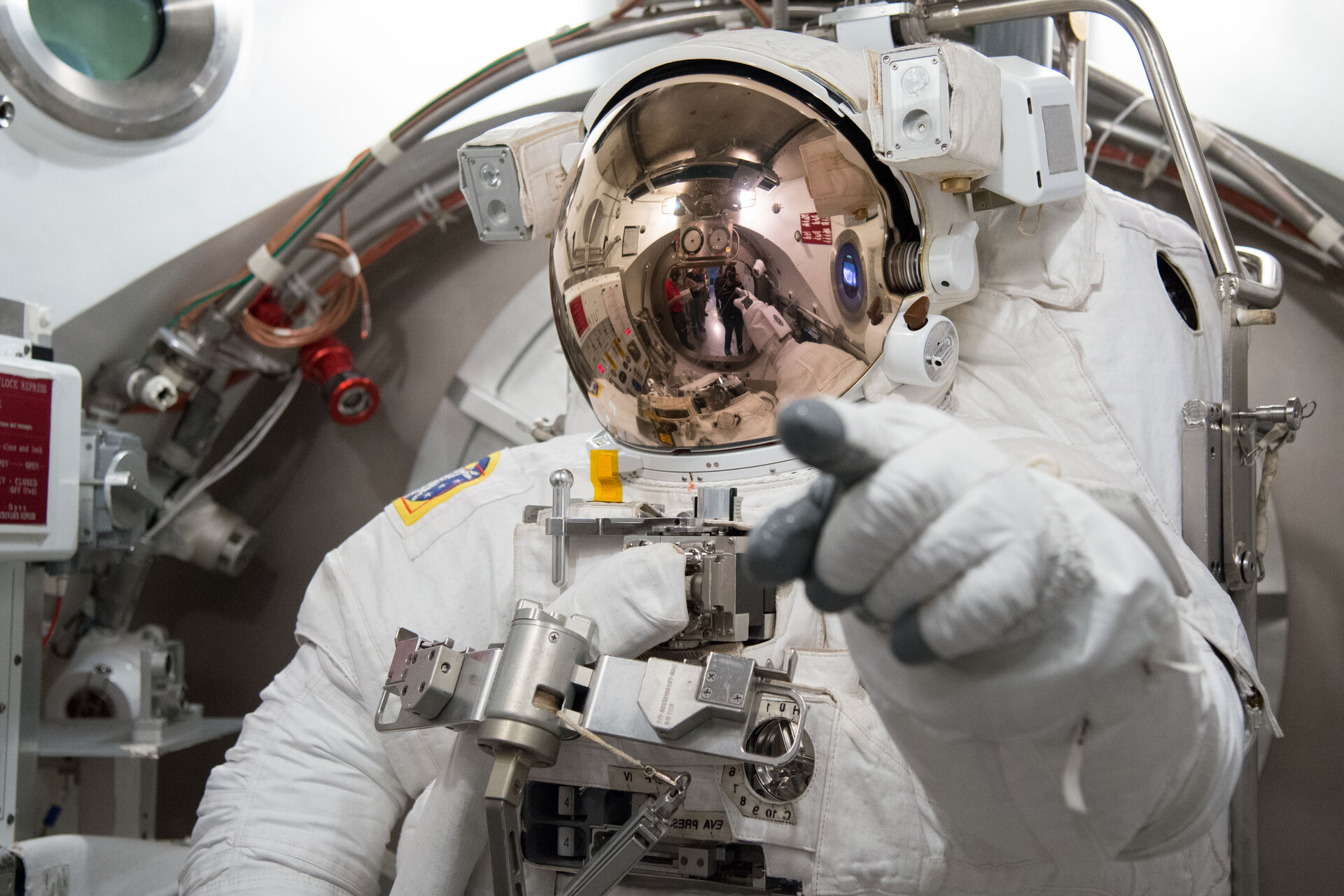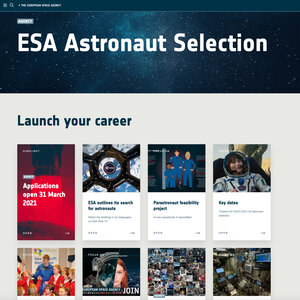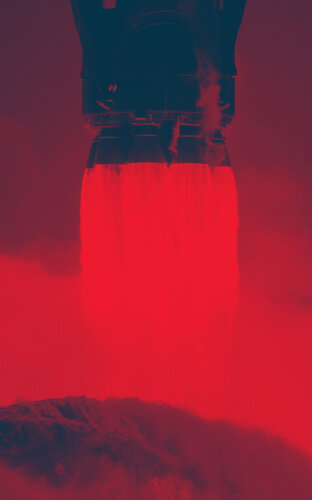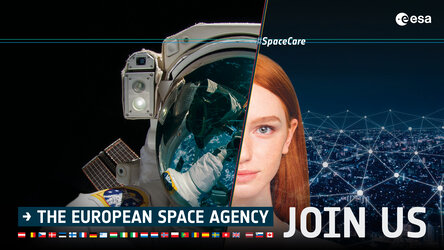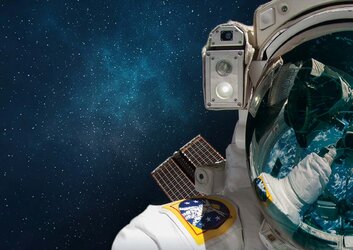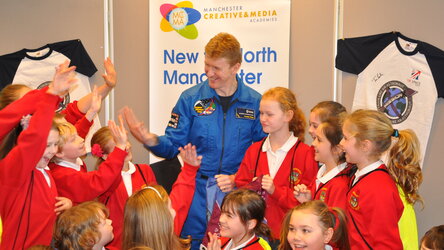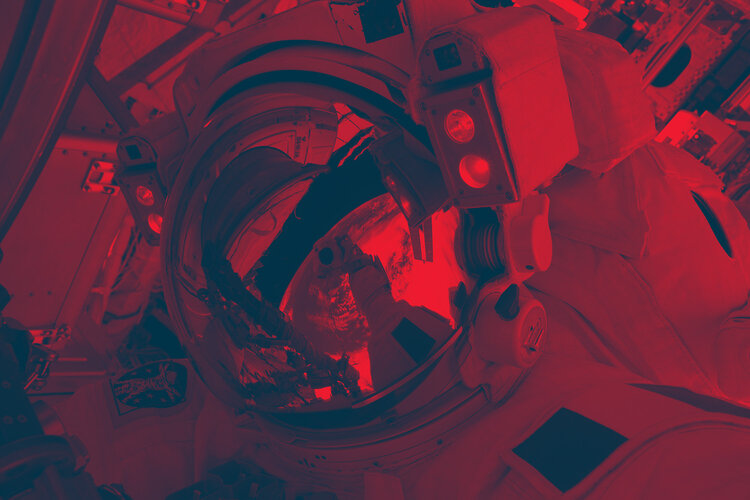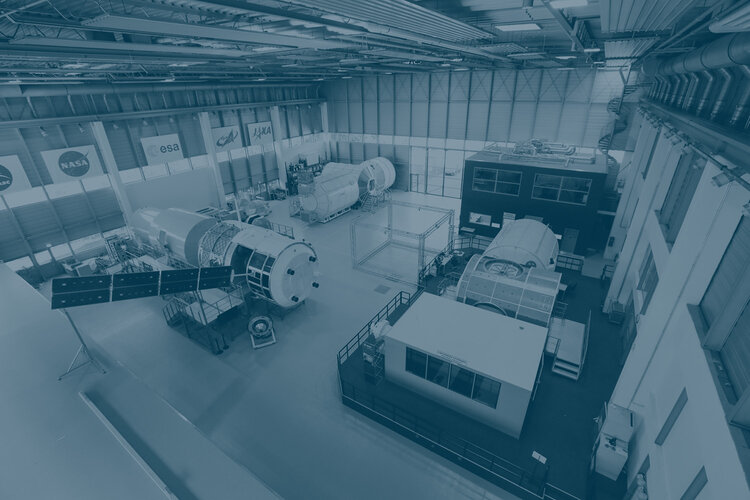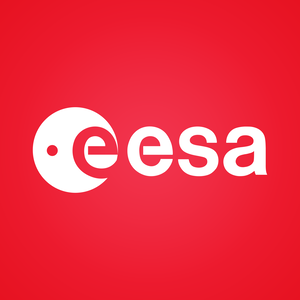Astronaut selection 2021-22 FAQs
The mission of the European Space Agency (ESA) is the peaceful exploration and use of space for the benefit of everyone. We watch over Earth, develop and launch inspiring and unique space projects, train astronauts and push the boundaries of science and technology, seeking answers to the big science questions about the Universe.
We are a community of scientists, engineers and business professionals from all over Europe working together in a diverse and multinational environment.
This page addresses some of the most frequently asked questions about becoming an ESA astronaut. If your question is not answered below, it may be answered in the Astronaut Applicant Handbook or vacancy notices.
**NEW** A message for candidates:
Thank you to everyone who applied to ESA’s Astronaut and Astronaut (with a disability) vacancies. Many applicants have inquired about when they will be notified about their application’s progress and what the next steps will be.
As you may have heard, the call for applications was hugely successful, attracting more than 23 000 candidates. This was far beyond ESA’s most optimistic forecasts and – while it is a very positive sign of the interest in space activities – processing this volume of applications requires a great deal of work. At ESA, we firmly believe that every application should receive the attention it deserves. With the considerable number of applicants, this simply takes more time than was initially foreseen.
Upon completion of the pre-screening stage, we concluded that some applications did not fulfil the requirements stated in the applicable documentation, and the concerned applicants were notified immediately. However, more than 80% of all remaining, eligible applications are still under review.
The next step for successful candidates is an invitation to a full day of testing at a facility in Europe. This step has already started and will last until at least the end of the year. Candidates are being invited progressively due to the work involved in this process and the need to consider COVID-19-related travel restrictions. Please note, if you have not yet been invited, this does not necessarily mean that your application is not being considered. We ask you for your patience as we process applications and issue these invitations.
We fully understand how important these applications are to candidates, and are working to let everyone who applied know the outcome of their application as soon as possible. Under the revised processing timeline, it is expected that you will be notified of the outcome of your application by the end of November 2021 at the latest.
Once again, we thank you wholeheartedly for your application and your patience as we select the next class of ESA astronauts.
Unique chance to apply
With 22 member states and 3 associate members, ESA is a truly transnational space agency. Nationals from Austria, Belgium, the Czech Republic, Denmark, Estonia, Finland, France, Germany, Greece, Hungary, Ireland, Italy, Luxembourg, the Netherlands, Norway, Poland, Portugal, Romania, Spain, Sweden, Switzerland and the United Kingdom plus Slovenia and Latvia may apply to the ESA Astronaut and Astronaut (with a physical disability) vacancy notices. As of 20 May 2021, nationals of Lithuania may also apply.
This is an exciting and also a rare occasion as, before this, ESA has issued a call for astronauts only three times since 1978 – the most recent being in 2008. ESA plans to recruit 4-6 new astronauts through its 2021-22 selection process to support the future of European space exploration. This campaign will select astronauts as career astronauts (the astronaut corps) or into the newly created reserve pool of astronauts. Unlike career astronauts, reserve astronauts will not be permanent ESA staff, but could have the opportunity to be selected for specific projects, as project astronauts. They may also have the opportunity to become career astronauts in the future.
On this page, frequently asked questions have been broken up into eight different sections. These are:
- The role of an astronaut
- ESA's exploration programme
- Life in space
- Eligibility and how to apply
- Qualifications and skills
- Health and physical condition
- Recruitment process and selection
New application deadline: due to Lithuania's new status as an ESA Associated Member, the application period was extended by three weeks. Applications for ESA's Astronaut and Astronaut (with a physical disability) vacancies closed 18 June 2021.
Any questions not answered here may be resolved in the Astronaut and Astronaut (with a physical disability) vacancy notices released on 31 March 2021. Please also refer to the Astronaut Applicant Handbook. Much of the important information is also visually represented in the astronaut selection media kit. We thank you for your patience in this process and wish you all the best for your application.
The role of an ESA astronaut
What is an Astronaut?
An astronaut is a person trained to serve as a professional crew member during a spaceflight beyond Earth’s atmosphere and to perform duties related to space exploration. Due to the challenges and hostility of life in space, astronauts spend a large part of their career training.
Representing all humankind, these space travellers test the limits of the human body in space, perform research, support the development of new technologies, and explore the wonders of the Universe in one of the most extreme environments imaginable.
Is there a centre in Europe for training European Astronauts?
Yes. ESA’s European Astronaut Centre (EAC) is located in Cologne, Germany. This is the home base for European astronauts and where all partner astronauts who fly to the International Space Station are trained in operation of the European Columbus laboratory. It is also where ESA astronaut candidates undertake their basic training. Most ESA astronauts are stationed here when not assigned to a mission. However, astronauts also spend a large part of their time traveling between other space agencies and training centres such as Roscosmos in Russia and NASA and SpaceX in the USA.
How many astronauts are currently active at ESA?
ESA’s astronaut corps currently comprises seven active Astronauts: Samantha Cristoforetti (IT), Alexander Gerst (GER), Matthias Maurer (GER), Andreas Mogensen (DEN), Luca Parmitano (IT), Tim Peake (UK), Thomas Pesquet (FR). Active ESA astronauts will continue to fly once the new class will join.
In addition to this, there are a number of older astronaut classes who continue to support and contribute to ESA and spaceflight more generally, though they no longer hold active flight roles.
What are an astronaut's duties and responsibilities?
Astronauts are highly skilled professionals who must be able to apply their considerable knowledge and expertise under circumstances of high stress and pressure, often being away from their families and regular social lives for extended periods.
To enable them to fulfil their duties, astronauts are uniquely trained. On top of that, ESA Astronauts are among the most visible players in human spaceflight and are natural ambassadors for ESA and its programmes. In this role, they attend events, participated in space-related discussions and are also very active in social and traditional media and education initiatives.
For more information on the duties and responsibilities of the ESA astronauts, please refer to the vacancy notices when these are released 31 March 2021.
What is the typical role of an ESA astronaut?
European astronauts currently participate in long-duration missions on the International Space Station, performing experiments in microgravity and operating the Station's systems. They assemble, activate and test new Station elements, undertake scientific research, perform spacewalks beyond the Space Station and act as test subjects in life sciences experiments.
The role of an astronaut is constantly evolving. In the future, astronauts must be prepared to venture farther from Earth as ESA participates in human and robotic missions to the Moon, and agencies work together to establish a sustainable lunar presence and look ahead to Mars.
What do astronauts do when they are not training for a flight?
Astronauts provide technical support to human and robotic space exploration projects, maintain their skills through refresher training or on-Earth missions and undertake public relations activities to communicate the importance of space and exploration. They are also very active on social media and make a number of public appearances, as their missions and tasks are of general curiosity to many Europeans.
How long is Astronaut training?
Astronaut training consists of three main phases: basic training, pre-assignment training and assigned crew or increment training.
Immediately after recruitment, astronaut candidates undertake one year of basic training at their duty station, the European Astronaut Centre. Training begins with information on ESA and other space agencies along with their main space programmes. After this introduction, trainees proceed to fundamentals across a wide range of systems: the International Space Station (ISS), transportation vehicles such as US commercial crew vehicles (SpaceX and Boeing) and the Russian Soyuz spacecraft. The operation of these systems including ground control are included. Basic training also builds astronautic skills required for specific tasks on the International Space Station such as extravehicular activities (spacewalks), robotics, spacecraft rendezvous and docking. Russian language, human behaviour and performance training as well as survival skills round off the basic training.
Pre-assignment training is the next step in astronaut training. This is a variable duration phase that provides astronauts from all International Space Station partners – NASA (USA), Roscosmos (Russia), ESA (Europe), JAXA (Japan) and CSA (Canada) – with knowledge and in-depth skills to operate, service and maintain the Station’s modules, systems, payloads and transport vehicles. This training is more detailed but still generic, supplying expertise that astronauts need for almost any flight to the Space Station. It includes specialisation in some functions, such as resource and data operations, robotics, navigation, maintenance, spacewalks, medical aspects and payloads. Lessons are conducted at all partner sites to allow first-hand familiarity with flight elements and operations. The astronauts also perform support tasks for ongoing missions in this phase.
Once an astronaut has been assigned to a mission, they begin increment training. This focuses on the specific mission tasks to be performed by the astronauts during their six-month stay on the International Space Station and takes about one and a half years. Skills and knowledge from the previous training are now applied to the experiment programme from scientists across Europe and beyond. The astronauts learn the scientific background and how to operate research equipment required for each experiment. They also prepare to run the spaceship components of the International Space Station, this includes monitoring and maintaining as well as repairing failed components. Intensive training for the crew transport vehicle, safe living on-board and emergency procedures complete preparation for the mission.
Astronaut training is constantly evolving in line with advances in technology and mission requirements. New formats such as virtual and augmented reality help make learning more immersive and enable remote training. Analogue courses such as ESA CAVES (Cooperative Adventure for Valuing and Exercising human behaviour and performance Skills) where Astronauts perform an exploration mission in a underground cave, NEEMO (NASA Extreme Environment Mission Operations) in which Astronauts live in an underwater research station for 2 weeks, or ESA’s geological field training course PANGAEA, also help Astronauts develop their skills and improve their knowledge in similar environments to those they may encounter beyond our planet.
Does gender make a difference in training?
No. All astronauts are trained to the same level of proficiency, regardless of gender. ESA is an equal opportunities employer and strongly encourages people of all genders to apply for all positions at ESA.
ESA's exploration programme
Where are we going next?
Exploring space is about travelling farther and coming back with new experiences and knowledge to help us on Earth. Our strategy includes three destinations where humans will work together with robots to gather new knowledge: low-Earth orbit on the International Space Station, the Moon and Mars. The three destinations share a common horizon goal, namely human presence on Mars.
After 20 years of continuous human habitation, the International Space Station and low-Earth orbit remains a valuable destination in its own right.
In the short term, ESA’s exploration programme also includes providing European service modules for NASA’s Orion spacecraft returning to the Moon, landing on the Moon with Roscomos’ Luna, and drilling into Mars with ESA’s ExoMars rover.
In the medium-term human presence around the Moon will be facilitated by a Gateway (Lunar station) where ESA is contributing a habitation module (I-Hab) and a module providing communication infrastructure, refuelling capabilities and a window (ESPRIT). An international robotic mission will also for the first time bring samples back from the surface of Mars, the Mars Sample Return (MSR) mission.
What will we do there?
Career astronauts will carry various activities on-board the International Space Station, ranging from performing scientific experiments (fundamental research in human physiology, biology, physical sciences) and technology demonstrations (applied research) to participating in Space Station maintenance activities.
Career astronauts will be fully integrated into International Space Station crews, and will also be involved in many important activities (e.g. science, EVA, cargo transfers, maintenance) sponsored by other international partner agencies. Project astronauts, should they be selected from the reserve, will focus on dedicated shorter duration missions. The scope of these missions may differ greatly. It is also expected that astronauts will communicate about and act as advocates for ESA’s exploration programme to the general public.
A Gateway farther afield than the International Space Station will be a springboard for sustainable lunar surface exploration and preparing for the next big leap to Mars. Robots will work hand in hand with astronauts and ground control to scout ahead, prepare landing sites and exploring places too dangerous or impractical for humans.
ESA will also work with reserve astronauts to become ambassadors for space in their respective countries.
What responsibilities will astronauts have in these new ventures?
- Gateway: Installing and running experiments internally and externally. Performing human research. Travelling to the lunar surface and supporting surface missions. Processing and returning lunar samples. Maintenance and assembly. Public engagement activities.
- Moon: Field geology, sample collection, deployment of scientific equipment, operation of robotic equipment, public engagement activities.
- Mars: Currently minimal, but expected to increase significantly in the long-term future.
Life in space
Do astronauts develop health problems during their stay in space?
Spaceflight is hazardous by its very nature and, off Earth, an astronaut’s wellbeing depends on life-support systems. Weightlessness and the space environment also do have negative impacts on human physiology. Most of them are recoverable such as loss of bone and muscle mass while in orbit. But radiation exposure needs to be monitored as for other radiation exposed workers.
ESA astronauts are supported by a dedicated space medicine team based at ESA’s European Astronaut Centre (EAC) in Cologne, Germany. This team is responsible for limiting or preventing the space environment from affecting the physical and mental health of astronauts. The environment and life-support systems on the International Space Station are continuously monitored and there is a thorough preventive and countermeasure programme in place.
Are there medical examinations in space?
A medical doctor, known as a flight surgeon, takes care of each astronaut before, during and after their flight. The astronaut and doctor remain in regular contact to discuss health issues and perform medical tests in space.
While some astronauts are qualified physicians or medical researchers, in general, there is no permanent doctor on board the International Space Station. Two astronauts are assigned as Crew Medical Officers and trained to provide medical support during their mission. These crew members offer basic medical support similar to a paramedic on Earth.
A medical checklist on the International Space Station helps astronauts diagnose and treat sick or injured crew members. Ground-based flight surgeons are also on-hand at all times to guide astronauts through this checklist and help make clinical decisions.
The crew has access to several medical kits for common drugs, such as aspirin or other mild pharmaceuticals, as well as an emergency medical kit with painkillers, anaesthetics, dental medication, bandages, stethoscopes, a defibrillator and other advanced life-support tools and medications.
Astronauts may also speak to their flight surgeon for 15 minutes once per week on a secure channel to discuss any medical issues. This is known as a private medical conference.
What about an astronaut's teeth?
Dental problems have occurred in space in the past. However, to minimise any potential issues, each astronaut’s dental condition is thoroughly analysed ahead of their flight. Fillings may be redone as a precaution.
In space, a basic emergency dental kit is available. Astronauts get hands-on training at ESA and NASA where they learn how to manage the most common dental problems in orbit.
What are the physical effects of a long stay in space?
A long stay in space has many physical consequences, including the loss of muscle and bone mass and strength, reduction of postural control and locomotion, and significant loss of blood volume and reduced cardiovascular capacity. However, these effects are temporary. ESA’s space medicine team helps each astronaut mitigate these through appropriate diet and exercise in space, and supports their rehabilitation when they return to Earth.
Is it true that astronauts lose bone mass in space? Can it be cured?
Depending on the level of physical exercise and the individual, astronauts can lose about 1% of their bone mass per month in space. The time required to recover this mass after a mission depends on the flight’s duration. For a long flight of around six months, it will take at least six months to return to pre-flight bone levels. It also depends on physical exercise: exercising during a mission speeds the recovery.
How is an astronaut’s day in space organised?
Each day in orbit (apart from rest days) is carefully planned by mission control. The working day on the Space Station counts 24 hours. After a quick rub down with a soapy cloth, the crew has breakfast and runs through the jobs for the day with mission control. These include performing scientific and technological experiments that sometimes involve speaking to scientists on Earth, maintenance, repairs, and general operation of the space station as well as public relations activities.
Astronauts enjoy three meals a day, with drinks and snacks always available. At least two hours each day are spent on physical exercise. This is essential to keep the crew fit and healthy. Loading a spacecraft with rubbish and unloading fresh supplies is an important task too. Many hours can also be spent getting ready for and performing spacewalks, also known as Extra Vehicular Activity (EVA).
How do astronauts eat in space?
Most of the food astronauts eat in space is packaged in cans or pouches and has to be prepared in a special way to ensure that it can be consumed in weightlessness. The most common preparation for space is dehydration. Astronauts rehydrate this food simply by putting it in their mouth or adding water. Other food items are thermostabilised, which involves heat processing to destroy harmful microorganisms and enzymes. Fresh fruits, vegetables and tortillas are also delivered by resupply missions, but must be consumed in the days immediately following their arrival to prevent spoilage.
How do astronauts go to the toilet in space?
The toilet is designed for use by all genders. Foot restraints hold the astronaut on the seat, while air currents pull waste into receptacles – one for each waste product. Urine is recycled into potable water and faeces are stored in sealed containers for removal by returning spacecraft.
How do astronauts shower in space?
Astronauts do not take showers in space. The International Space Station recycles as much as possible and water is one of the most precious resources. Showers are not convenient in weightlessness – water just floats around, so astronauts use wet towels instead.
How do astronauts sleep in space?
Due to the microgravity environment, there is no ‘up’ or ‘down’ in space. As a result, astronauts are weightless and can sleep in any orientation they wish, but each has their own crew cabin and a sleeping bag that they strap to the wall to keep them from floating around.
What do astronauts wear in space?
Astronauts generally wear ordinary clothes such as t-shirts and trousers on the International Space Station. They also wear socks, but no shoes, as they often use footholds placed around the Station to keep themselves steady while working.
As there is no washing machine on the Space Station, it is hard to pack enough clothes like underwear or socks, because each kilogram launched into space must be carefully managed. As a result, they cannot change their clothes every day. Underwear is changed every two to three days. On average astronauts get one pair of shorts and a t-shirt every three days for exercising. Their work shirts and trousers/shorts are changed on average once every 10 days.
During their launch and return to Earth, astronauts wear a spacesuit. This suit differs depending on their spacecraft. While on mission, astronauts may also wear a different kind of spacesuit to perform tasks outside the Station. European Astronauts performing spacewalks from the International Space Station typically wear NASA’s extravehicular mobility unit, or EMU suit. Suits used by Astronauts to perform spacewalks on the lunar surface will be different again and are currently in development by NASA.
Do astronauts have free time in space?
The crew normally enjoy some free time before bed. They also have free time on the weekends. This is when they might write emails home or talk to their families, watch movies, read books, or play music or games. But the most popular leisure pursuit in space is looking out the window, watching Earth turning below, taking photos and videos and sharing them with everybody on ground.
Eligibility and how to apply
Who can apply?
ESA is an equal opportunities employer, committed to achieving diversity within the workforce and creating an inclusive working environment. Anyone who meets the requirements of an ESA job description is encouraged to apply. Applications from women are strongly encouraged.
How and where can I apply?
The vacancy notices were posted to the ESA careers website on 31 March 2021. Only applications made online through the ESA careers website and submitted before the vacancy closes on 18 June 2021 can be considered. Applications submitted after the deadline will not be accepted.
To apply, you will need to create an account and upload the documents specified in the vacancy notice, namely a CV in the Europass format, a motivation letter, a copy of your passport and a European Part-MED, Class 2 (Private Pilot) medical certificate issued by an aviation medical examiner or aeromedical centre. For the purpose of the astronaut selection ESA will accept UK CAA and Canada CAR certificates for private pilots. USA FAA certificates for private pilots can also be accepted by equivalence. If you do not yet have the formal medical certificate in hand at the time of application, ESA will also accept your official medical report. The certificate may be provided at a later date if required.
Please note, if you are having difficulties in getting a new passport due to the current situation and travel limitations, you may proceed with your application by uploading a valid ID card, together with a proof of the request of the new passport. For applicants living outside Europe/Schengen area: a valid passport is necessary for travelling in the different phases of the selection.
For the Astronaut (with a physical disability) vacancy you will need to upload a medical certificate issued in English by any physician and stating that, if not for your disability, you would comply with the medical requirements of the European Part-MED, Class 2 (Private Pilot) medical certificate. These requirements are available here. Requirements for UK CAA, Canada CAR and USA FAA certificates for private pilots will also be accepted. In a second stage you might be requested to provide a medical report and associated documentation related to your disability. Applicants will be instructed individually.
In addition to completing the application form and attaching the aforementioned documents, you will need to answer a questionnaire which will play a major role in the first stage of the selection process.
What are the nationality requirements?
According to the ESA Convention, applications can only be considered from nationals of an ESA Member State or Associated Member State. These are: Austria, Belgium, the Czech Republic, Denmark, Estonia, Finland, France, Germany, Greece, Hungary, Ireland, Italy, Luxembourg, the Netherlands, Norway, Poland, Portugal, Romania, Spain, Sweden, Switzerland and the United Kingdom plus Slovenia, Latvia and Lithuania.
What documents are required to apply?
To apply you will need a detailed and updated CV and motivation letter in English as well as the required medical certificate. The formal Europass template must be used for your CV to apply. We strongly advise to be to be succinct and relevant in your motivation letter, tailoring this according to the requirements of the vacancy.
Qualifications and skills
What qualifications are needed to apply?
Applicants must have a minimum of a Master’s degree from a recognised academic institution in natural sciences (including physical sciences; Earth, atmosphere or ocean sciences; biological sciences), medicine, engineering or mathematics/computer sciences, with at least three years of professional experience after graduation. This could include working in a lab, conducting research in the field or working in a hospital. A PhD or equivalent degree, or additional Master’s degrees in the aforementioned subject areas, are considered an asset.
A degree as Experimental Test Pilot and/or Test Engineer from an official Experimental Test Pilot School is also accepted. These institutions include EPNER (France), ETPS (England), USAF TPS (US Air Force) and USNTPS (US Navy). Commercial school NTPS is also included here. Candidates with these qualifications will be assessed on a case-by-case basis and may be asked to provide a copy of their diploma or statement from their school regarding the level of the qualification.
Does PhD research count towards professional experience?
Yes, experience gained during PhD research/studies does count towards the three years of professional experience required to apply.
What are the requirements to apply?
The vacancy notices show both the minimum requirements that every candidate has to fulfil as well as asset criteria that are considered highly desirable. These asset criteria will also be taken into consideration, especially as we expect a high volume of applications.
In addition to the requirements and criteria indicated in the vacancy notice, below are further requirements that every candidate must fulfil. Some of the below requirements will form part of the extensive training programme astronauts must undertake.
- The duties of an astronaut require moderate to arduous physical exertion involving walking, running, standing, heavy lifting, crouching, crawling, and exposure to inclement weather. Astronauts need to be willing to perform arduous physical activities as part of their duties.
- Astronaut candidates will be required to pass a swimming test during the first month of training. Therefore, astronauts need to be willing to submit to a swimming test.
- The duties of an astronaut require participation in flight operations in a parabolic flight aircraft to simulate microgravity and adjustment to zero gravity environments. Astronauts need to be willing to undergo this type of flight training.
- To simulate microgravity in space, astronaut candidates and astronauts participate in training that requires extended time underwater (up to 8 hours a day), using SCUBA gear or the Extravehicular Mobility Unit (EMU, or spacesuit). Therefore, astronauts need to be willing to spend extended time training underwater.
- To be mobile in certain locations, astronauts are required to hold a driving licence. Therefore, candidates, who do not yet possess a valid driving licence for their home country or an international driving licence, must be willing to obtain one.
- It is paramount that astronauts work well in a team, even in confined spaces and under stressful conditions. Therefore, it is considered an asset if applicants have already had opportunities to support effective teamwork and reach challenging group objectives.
- Space travel is associated with many risks and dangers. Therefore, it is considered an asset if applicants have had to experience activities associated with personal exposure, which required from them a sound risk management capability.
Despite all of the requirements outlined in the vacancy notices, if you are truly motivated and you meet the minimum requirements, but you are not sure you fulfil all the asset criteria, you should still apply.
All applications are welcome!
What are the top traits of a potential candidate?
The ability to work well as part of an intercultural, interdisciplinary team and remain calm under pressure is essential for all ESA astronauts. ESA by its very nature is multicultural, and you will be working closely with people from all different backgrounds, all over the world and in challenging situations – clear, concise and considerate communication is a must.
Astronaut candidates should also possess excellent fine motor skills, strong analytical and reporting skills, the ability to rapidly assimilate and synthesise complex information and sound decision-making capabilities. You will need to absorb a lot of complex information throughout your training, and must learn to prioritise this to ensure you perform to a consistently high standard while in space.
The workload of an astronaut is high and working hours can be irregular. This requires a high level of motivation. You must be flexible and able to cope with frequent travel both within and outside of Europe, and even off Earth. You must also be willing to spend extended periods of time away from relatives or to be stationed outside your home country as you undergo intensive training, missions or assignments.
As astronauts are some of the most visible ambassadors of Europe’s space programme, they are also expected to participate in public relations and education activities and should be passionate about sharing their knowledge, with a willingness to engage wide audiences – particularly the younger generation – around ESA and space exploration. Following your mission(s) there is also the expectation that ESA astronauts remain in the public domain for a significant time.
What are the language requirements?
Applicants must be able to speak and write English well (minimum CEFR C1). Good knowledge of another foreign language and any other additional languages is a plus. Speaking Russian is an asset, but not a requirement. This is the second official language on the International Space Station and is taught during the astronaut training.
Is there an age limit?
Every space mission represents an extremely high investment for all stakeholders involved. For this reason, and to ensure that each recruited astronaut can fulfil at least two missions during their employment with ESA prior to retirement, ESA is obliged to set a maximum age limit of 50 years. This means that applications from anybody older than 50 at the time of applying cannot be taken further in the selection process.
Health and physical condition
Which medical and psychological standards are used to select the candidates?
An ESA astronaut requires a multitude of skills, capabilities and characteristics. One important component of the selection process is an assessment of medical and psychological health. Candidates must demonstrate cognitive, mental and personality capabilities to allow them to work efficiently in an intellectually and socially demanding environment. Applicants are also expected to be free from any type of drug dependency.
Typical medical and psychological health standards are used. These standards are derived from evidence-based medicine, verified by clinical studies. Specifics are listed below:
- An applicant to the Astronaut vacancy should be able to pass a European Part-MED, Class 2 medical examination (Private Pilot medical certificate), conducted by an Aviation Medical Examiner certified by their national Aviation Medical Authority. For the purpose of the astronaut selection ESA will accept UK CAA and Canada CAR certificates for private pilots. USA FAA certificates for private pilots can also be accepted by equivalence.
- An applicant to the Astronaut (with a physical disability) vacancy shall provide a medical certificate issued in English by any physician and stating that, if not for your disability, you would comply with the medical requirements of the European Part-MED, Class 2 (Private Pilot) medical certificate. These requirements are available here. Requirements for UK CAA, Canada CAR and USA FAA certificates for private pilots will also be accepted. In a second stage you might be requested to provide a medical report and associated documentation related to your disability. Applicants will be instructed individually.
- The applicant must be free from any disease.
- The applicant must be free from any dependency on drugs, alcohol or tobacco.
- The applicant must have the normal range of motion and functionality in all joints. This requirement does not apply to the applicants to the astronaut with physical disabilities vacancy.
- The applicant must have visual acuity in both eyes of 100% (20/20 vision) naturally or after correction with glasses or contact lenses.
- The applicant must be free from psychiatric disorders.
- The applicant must demonstrate cognitive, mental and personality capabilities to allow them to work efficiently in an intellectually and socially demanding environment.
In order to overcome the challenges and complexities in such a hostile environment as space, the astronauts need to fulfil a set of physical, medical and psychological health standards. Being an astronaut is extremely demanding on the body and mind, with long periods away from family and friends, high workload and irregular working hours and with routines beyond the comfort zone. The wellbeing of the astronaut, alongside that of the whole team, is the condition for the success of each mission.
For the above reasons, all applicants must upload onto their application form a medical certificate as mentioned above. It is not required to hold a PPL but astronauts need to be medically fit to exercise the duties of a private pilot. The uploaded medical certificate will only be visible to, and will be verified by, the ESA personnel responsible for the first screening of applications as well as the ESA medical board. The certificate will remain in your application file to which only the aforementioned personnel have access. If you do not have the official medical certificate in hand at the time of application, you may upload the official medical report provided by your aviation medical examiner. However, the formal certificate will be required should you progress to the next stage of selection.
What level of fitness is required?
It is important to be healthy but ESA does not look for extreme fitness or high-level athletes. Over-developed muscles may actually be a disadvantage for astronauts living in weightlessness. There is no specific sport we recommend. Physical activity in general is beneficial to health. In terms of the selection process, the physical fitness and medical components are either pass or fail. It is not a graduated system.
What preparation is necessary for the medical tests?
During the medical selection, applicants undergo a number of tests across many areas. Some tests are physically demanding, like bicycle or treadmill exercises. Some may be invasive and others may be just questionnaires. There is nothing you can do generally to prepare for these medical examinations. If an examination requires specific preparation, such as fasting before giving a blood sample, you will be advised in advance.
What are the eyesight requirements to apply?
In terms of initial visual range requirements, the medical standards for pilots apply.
The main tests applicants must pass include visual acuity, colour perception and 3D vision. Wearing glasses or contact lenses is not a reason for disqualification in itself, but would be evaluated if a visual defect is known to progress rapidly and could be a reason for disqualification. Minor visual defects that require corrective lenses to achieve perfect vision are acceptable.
Some surgical interventions to correct visual acuity can lead to disqualification, while other surgeries are acceptable – each case is evaluated on an individual basis.
What are the hearing requirements to apply?
Applicants cannot have any hearing impairment, i.e. they have to have a hearing capacity of 25dB or better (better ear) according to the definition of the World Health Organisation (WHO). This zero-impairment requirement is necessary as astronauts are sometimes exposed to high levels of noises while, at the same time, they need to ensure communication over radio with the ground for safety reasons.
What are the height requirements to apply?
The European Space Agency is recruiting astronauts to implement its Human Space Exploration programmes. These programmes are prepared in partnership with other space agencies and the activities are shared among them.
Human launch capability is currently provided either by the USA or the Russian Federation. ESA must assign astronauts who comply with the body size requirements of the vehicles used by these partner agencies. Height is just one of these requirements.
Persons shorter than 150cm and taller than 190 cm are not able to be assigned to a space mission at the current time due to the size requirements of the launch vehicles. These limits will therefore be applied to the selection of ESA astronauts. There is an opportunity for persons short in stature (less than 130cm) to apply to ESA's Astronaut (with a physical disability) vacancy.
Please note, the height limits are dictated by technical constraints. An inability to fulfil them does not reduce the value of any individual. Persons at the lower or upper limit of body size should exercise their judgement in assessing whether it is worthwhile to invest time and money in an application that at some point, might fail for this reason.
ESA and its staff are fully aware of the arbitrary nature of these limits and wish to reevaluate them and some others. This is exactly the nature of ESA's feasibility study "Fly!". This project aims to select (a) person(s) with an identified physical disability to help the ESA define the modifications necessary for space vehicles to accommodate, or processes to enable, space travel for a wider range of astronauts.
ESA is committed and will work toward this goal, however there is currently no guarantee that a person of small stature (<130 cm) will fly to space at the end of the process.
What are the psychological and intellectual requirements?
General characteristics expected of applicants include but are not limited to: good reasoning capability, the ability to work under stress, memory and concentration skills, aptitude for spatial orientation, psychomotor coordination and manual dexterity. A candidate’s personality should show high motivation, flexibility, gregariousness, empathy, non-aggression and emotional stability.
In view of the very specific demands placed on astronauts, both in training and in space, the selection process focuses particularly on the psychological health standards required for an astronaut and applies psychometric testing throughout many of the selection stages. In addition, the selection process entails a medical screening on the basis of international standards of long-term missions in space.
What is ESA's pregnancy and maternity policy for active astronauts?
As an employer, ESA supports its staff in all phases of their lives. This includes supporting astronauts during pregnancy and maternity. Some periods in the life of an astronaut – such as spaceflight and training – are more physically and mentally demanding than others. However, astronauts are supported by the ESA medical team and duties can be assessed in light of this. Many women have enjoyed successful astronaut careers while being mothers. This is also the case at ESA.
Can people who are currently pregnant apply to ESA's astronaut selection?
In the case that an applicant cannot be awarded the required medical certificate due to pregnancy at the time of application, ESA will accept a letter from the aeromedical examiner stating that the examinations have been done, provided satisfactory results and the person is temporarily unfit due to pregnancy only.
Additional note on disabilities
If you have any physical disability and you are confident that you fulfil all requirements of the astronaut vacancy notice, you can apply. You need to compete in all tests during the selection process along with the other applicants. In addition, ESA is pioneering a feasibility study to allow individual(s) with a physical disability into space. As a first step, ESA is publishing a dedicated vacancy notice to select individuals with physical disabilities for the astronaut reserve. This Astronaut (with a physical disability) vacancy was published on the ESA careers website alongside the Astronaut vacancy notice on 31 March 2021.
Recruitment process and selection
How to track the application once submitted?
All the applications receive an automatic acknowledgement of receipt. Once you have applied, you will be able to track the status of your application. All candidates, whether they are selected for the next step of the selection process or not, are informed, by email, about the outcome of their application. Any specific enquiries concerning your future or current application that are not answered by these FAQs should be sent to astronaut.recruitment@esa.int.
What is the next step once the applications deadline is due?
The vacancy notice will be open for 11 weeks, starting from 31 March until 18 June 2021. The initial deadline of 28 May was extended by three weeks on 20 May due to the addition of Lithuania to ESA's Associated Members. Only the applications sent through the ESA careers website will be considered.
*NEW* When will I be notified about my application?
Thank you to everyone who applied to ESA’s Astronaut and Astronaut (with a disability) vacancies. Many applicants have inquired about when they will be notified about their application’s progress and what the next steps will be.
As you may have heard, the call for applications was hugely successful, attracting more than 23 000 candidates. This was far beyond ESA’s most optimistic forecasts and – while it is a very positive sign of the interest in space activities – processing this volume of applications requires a great deal of work. At ESA, we firmly believe that every application should receive the attention it deserves. With the considerable number of applicants, this simply takes more time than was initially foreseen.
Upon completion of the pre-screening stage, we concluded that some applications did not fulfil the requirements stated in the applicable documentation, and the concerned applicants were notified immediately. However, more than 80% of all remaining, eligible applications are still under review.
The next step for successful candidates is an invitation to a full day of testing at a facility in Europe. This step has already started and will last until at least the end of the year. Candidates are being invited progressively due to the work involved in this process and the need to consider COVID-19-related travel restrictions. Please note, if you have not yet been invited, this does not necessarily mean that your application is not being considered. We ask you for your patience as we process applications and issue these invitations.
We fully understand how important these applications are to candidates, and are working to let everyone who applied know the outcome of their application as soon as possible. Under the revised processing timeline, it is expected that you will be notified of the outcome of your application by the end of November 2021 at the latest.
Once again, we thank you wholeheartedly for your application and your patience as we select the next class of ESA astronauts.
What is the process for selection?
The selection process consists of six selection stages, expected to last from the closure of the vacancy notice on 18 June 2021 to the worldwide announcement of the selected astronauts around October 2022.
The selection stages
Below is a short summary of each selection stage. If you are invited to one of the test phases or interview rounds, you will receive additional information for that particular selection stage together with your invitation.
- Receiving applications: all applicants must submit an online application through the ESA careers website before the closure of the vacancy.
- Stage 1: Screening. Several screening rounds will be conducted on the basis of all documents submitted with the application form as well as the screening questionnaire that you will have completed as part of your application.
- Stage 2: Test Phase 1 consists of cognitive, technical, motor coordination and personality tests.
- Stage 3: Test Phase 2 is an assessment centre consisting of psychometric tests, group and individual exercises as well as practical tests.
- Stage 4: Test Phase 3 is a medical selection that will test your physical and mental abilities against international medical standards for long-duration astronaut missions.
- Stage 5: Interview Round 1 is a panel interview that will test your technical and behavioural competencies. At this stage, your educational qualifications will be verified and a criminal record check carried out.
- Stage 6: Interview Round 2 is the last selection stage, consisting usually of an interview with the Director General of ESA, after which the final decision will be taken.
It is currently foreseen that all of the test phases and interview rounds will be held face-to-face and will therefore require travel to different locations across Europe. Assuming that the COVID-19 circumstances do not ease in the near future, travel restrictions and protective measures will need to be taken which may also have an impact on the timelines.
How long will selection take?
The entire selection process is quite lengthy and will take more than a year. Please prepare yourself mentally for such a strenuous process and the related waiting times.
After every selection stage, only those candidates who fulfil the requirements or criteria and/or perform the best in the tests compared to the other candidates will continue. You will be notified at each stage if you are successful or not in moving to the next one. We expect to receive a high number of applications for this vacancy, which may mean that it takes some time before you are informed of the outcome of any given stage.
For this same reason, while every candidate will be informed of the outcome of their application, only those who do not pass the medical screening or interview rounds 1 and 2, i.e. from Stage 5/6 of the selection process onwards, may be given verbal feedback. This will be provided on request.
If you succeed at any stage: congratulations, you are one step closer to becoming an astronaut!
Should you not succeed, please do not be discouraged. The astronaut selection is highly competitive and geared towards a very specific candidate profile. But there are other exciting opportunities to work for ESA. We would encourage you to check out other vacancies we publish.
What kind of contract are astronauts offered?
The aforementioned selection process aims to recruit around four candidates who will be offered an ESA staff contract for an initial duration of four years. This may be extended into an indefinite duration contract if the applicable conditions are met. The candidates offered such a contract will immediately join the ESA astronaut corps as career astronauts.
In addition to recruiting astronauts into the existing corps, ESA will for the first time also establish an astronaut reserve. This reserve will be composed of the candidates who were successful throughout the entire selection process and were not recruited, should they agree to join it. Astronauts in the reserve will remain employed by their current employers, but they will maintain an annual medical certification and benefit from specific training about ESA’s programmes. They can be called for specific spaceflight missions if and when they arise. If they are offered the opportunity to participate in a mission, they will have to agree to being recruited by ESA as staff for the duration of that mission.
What happens to candidates that reach the final round but are not selected?
Candidates who are successful throughout the entire selection process, but are not recruited, will be offered the possibility to join the astronaut reserve.















 Germany
Germany
 Austria
Austria
 Belgium
Belgium
 Denmark
Denmark
 Spain
Spain
 Estonia
Estonia
 Finland
Finland
 France
France
 Greece
Greece
 Hungary
Hungary
 Ireland
Ireland
 Italy
Italy
 Luxembourg
Luxembourg
 Norway
Norway
 The Netherlands
The Netherlands
 Poland
Poland
 Portugal
Portugal
 Czechia
Czechia
 Romania
Romania
 United Kingdom
United Kingdom
 Slovenia
Slovenia
 Sweden
Sweden
 Switzerland
Switzerland


























